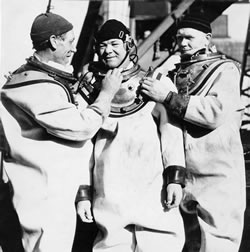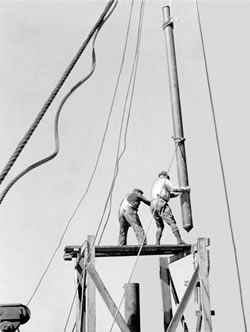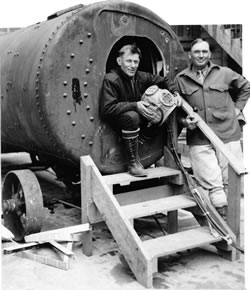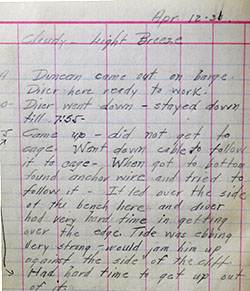
One of the greatest construction challenges took place underwater. The south tower was located more than 1,100 feet (335 meters) from the San Francisco shore. To build the south tower structures, divers played a critical role descending up to 110 feet (33 meters) into the tumultuous waters of the Golden Gate Strait. They placed dynamite charges and removed loose material down to bedrock with high-pressure hoses. Later, they descended to guide the positioning of the forms and funnels used to place the concrete for the south tower fender.
Divers worked in water that was dark, murky and cold, and only when the tide changed and the usually strong currents lessened, which occurred four times in a day. Portable air tanks for diving had not yet been invented. A diver’s life depended on the continuous pumping of air through a long hose to the surface.
Image shown above courtesy of the San Francisco Historical Society - Huggins Collection - CHS.Huggins.002
Learn More
 |
Divers in their heavy gear, prior to putting on helmets.
|
 |
Workers load explosive charges into a framework that is then lowered to the seafloor and positioned by divers.
|
 |
If a diver surfaced too quickly, air bubbles could be released into the bloodstream, a condition called "the bends." Decompression chambers were kept nearby just in case.
|
 |
Field notes of the difficulty of a diver working on the seafloor from the Golden Gate Bridge, Highway and Transportation District - An excerpt from field notes explaining the difficulty of a diver working on the seafloor because of its irregular topography and the strength of the tidal current. |
Explore this Topic Further
Underwater Construction
Underwater Construction from PBS American Experience (grade 3 to adult)
Working underwater to construct the foundations was a dangerous job. Construction workers in cumbersome diver suits were exposed to cold water and strong currents and could barely see in the murky water. They went down 90 to 100 feet and had to worry about decompression sickness, also called caisson disease or the bends, if they came to the surface too quickly.
Caisson Disease from PBS American Experience (grade 3 to adult)
This provides a brief description of the causes of caisson disease (the bends), and explains the problem posed for underwater construction workers that was beginning to be prevented through standardized recompression procedures. The decompression chamber was invented in 1916.
Pressure Increase with Ocean Depth from the National Oceanic and Atmospheric Administration (grade 3 to adult)
The divers working on the Bridge foundation 90 feet below the water’s surface experienced about 40 psi pressure from the weight of the water around them. This web site describes how pressure increases with depth under the ocean.
San Francisco Bay Tides and Currents from the National Oceanic and Atmospheric Administration (grade 3 to adult)
Find out about the water level, current speed and direction, temperature, and salinity underneath the Golden Gate Bridge during the most recent 24- hour period.
A Bathtub for the South Tower from the Golden Gate Bridge Highway and Transportation District (GGBHTD) (all ages)
The construction of the south pier in deep, fast moving water required construction of a concrete fender walls to protect the area from the currents and stray ships. Divers were instrumental in constructing the fender and foundation.
Interoffice Memo About Recompression Chambers from the Golden Gate Bridge Highway and Transportation District (GGBHTD) (all ages)